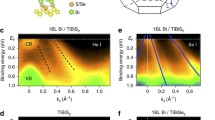Abstract
Topological insulators are new class of materials which are characterized by a bulk band gap like ordinary band insulators but have protected conducting states on their edges or surfaces. These states emerge due to the combination of spin-orbit coupling and time reversal symmetry. Also, these states are insensitive to scattering by non-magnetic impurities. A two-dimensional topological insulator has one dimensional edge states in which the spin-momentum locking of the electrons give rise to quantum spin Hall effect. A threedimensional topological insulator supports novel spin-polarized 2D Dirac fermions on its surface. These topological insulator materials have been theoretically predicted and experimentally observed in a variety of 2D and 3D systems, including HgTe quantum wells, BiSb alloys, and Bi2Te3, Bi2Se3 crystals. Moreover, proximity induced superconductivity in these systems can lead to a state that supports zero energy Majorana fermions, and the phase is known as topological superconductors. In this article, the basic idea of topological insulators and topological superconductors are presented along with their experimental development.
Similar content being viewed by others
Suggested Reading
K V Klitzing, G Dorda and M Pepper, New Method for High-Accuracy Determination of the Fine-Structure Constant Based on Quantized Hall Resistance, Phys. Rev. Lett., Vol.45, p.494, 1980.
X-L Qi and S-C Zhang, The Quantum Spin Hall Effect and Topological Insulators, Phys. Today, Vol.63, p.33, 2010.
J Moore, The Birth of Topological Insulators, Nature Phys., Vol.5, p.378, 2009.
J Maciejko, T L Hughes and S C Zhang, The Quantum Spin Hall Effect, Annu. Rev. Condens. Matter Phys., Vol.2, p.3153, 2011.
M Z Hasan and J E Moore, Three-Dimensional Topological Insulators, Annu. Rev. Condens. Matter Phys., Vol.2, p.55, 2010.
M Z Hasan and C L Kane, Colloquium: Topological Insulators, Rev. Mod. Phys., Vol.82, p.3045, 2010.
X L Qi and S C Zhang, Topological Insulators and Superconductors, Rev. Mod. Phys., Vol.83, p.1057, 2011.
M König, S Wiedmann, C Brüne, A Roth, H Buhmann, L W Molenkamp, X-L Qi, and S-C Zhang, Quantum Spin Hall Insulator State in HgTe Quantum Wells, Science, 318, 766, 2007.
D Hsieh, D Qian, L Wray, Y Xia, Y S Hor, R J Cava, and M Z Hasan, A Topological Dirac Insulator in a Quantum Spin Hall Phase: Experimental Observation of First Strong Topological Insulator, Nature, Vol.452, p.970974, 2008.
Y Xia et al., Observation of a large-gap topological-insulator class with a single Dirac cone on the surface, Nature Phys., Vol.5, p.398, 2009.
H Zhang, C X Liu, X L Qi, X Dai, Z Fang and S C Zhang, Topological Insulators in Bi2Se3, Bi2Te3 and Sb2Te3 with a single Dirac cone on the surface, Nature Phys., Vol.5, p.438442, 2009.
C L Kane and E J Mele, Quantum Spin Hall Effect in Graphene, Phys. Rev. Lett., Vol.95, p.226801, 2005.
B A Bernevig, T L Hughes and S-C Zhang, Quantum Spin Hall Effect and Topological Phase Transition in HgTe Quantum Wells, Science, Vol.314, p.1757, 2006.
D Pesin and A H MacDonald, Spintronics and Pseudospintronics in Graphene and Topological Insulators, Nature Materials, Vol.11, p.409, 2012.
M V Berry, Quantal Phase Factors Accompanying Adiabatic Changes, Proc. R. Soc., Lond., Vol.A392, No.45, 1984.
L Fu and C L Kane, Superconducting Proximity Effect and Majorana Fermions at the Surface of a Topological Insulator, Phys. Rev. Lett., Vol.100, p.096407, 2008.
J Alicea, New Directions in the Pursuit of Majorana Fermions in Solid State Systems, Rep. Prog. Phys., Vol.75, p.076501, 2012.
C W J Beenakker, Search for Majorana Fermions in Superconductors, Annu. Rev. Condens.Matter Phys., Vol.4, p.113, 2013.
T D Stanescu and S Tewari, Majorana Fermions in Semiconductor Nanowires: Fundamentals, Modeling, and Experiment, J. Phys. Condens. Matter, Vol.25, p.233201, 2013.
M Leijnse and K Flensberg, Introduction to Topological Superconductivity and Majorana Fermions, Semicond. Sci. Technol., Vol.27, p.124003, 2012.
C Nayak, S H Simon, A Stern, M Freedman and S D Sarma, Non-Abelian Anyons and Topological Quantum Computation, Rev. Mod. Phys., Vol.80, p.1083, 2008.
A Y Kitaev, Unpaired Majorana Fermions in Quantum Wires, PhysicsUspekhi, Vol.44, p.131, 2001.
Y Oreg, G Refael and F von Oppen, Helical Liquids and Majorana Bound States in Quantum Wires, Phys. Rev. Lett., Vol.105, p.177002, 2010.
R M Lutchyn, J D Sau and S D Sarma, Majorana Fermions and a Topological Phase Transition in SemiconductorSuperconductor Heterostructures, Phys. Rev. Lett., Vol.105, p.077001, 2010.
V Mourik et al., Signatures of Majorana Fermions in Hybrid SuperconductorSemiconductor Nanowire Devices, Science, Vol.336, p.1003, 2012.
A Das et al., Zero-bias Peaks and Splitting in an AlInAs Nanowire Topological Superconductor as a Signature of Majorana Fermions, Nature Phys., Vol.8, p.887, 2012.
Author information
Authors and Affiliations
Corresponding author
Additional information
Arijit Saha is a Reader-F at the Institute of Physics, Bhubaneswar. His research interest lies broadly in the areas of mesoscopic physics and strongly correlated electrons.
Arun M Jayannavar is a Senior Professor at the Institute of Physics, Bhubaneswar. His research interest lies in different aspects of mesoscopic physics and statistical mechanics.
Rights and permissions
About this article
Cite this article
Saha, A., Jayannavar, A.M. Emerging trends in topological insulators and topological superconductors. Reson 22, 787–800 (2017). https://doi.org/10.1007/s12045-017-0527-5
Published:
Issue Date:
DOI: https://doi.org/10.1007/s12045-017-0527-5




